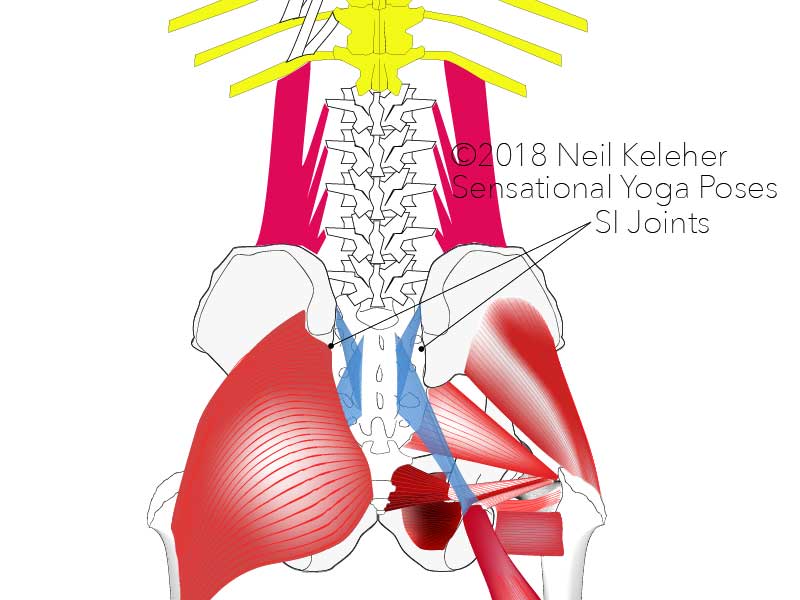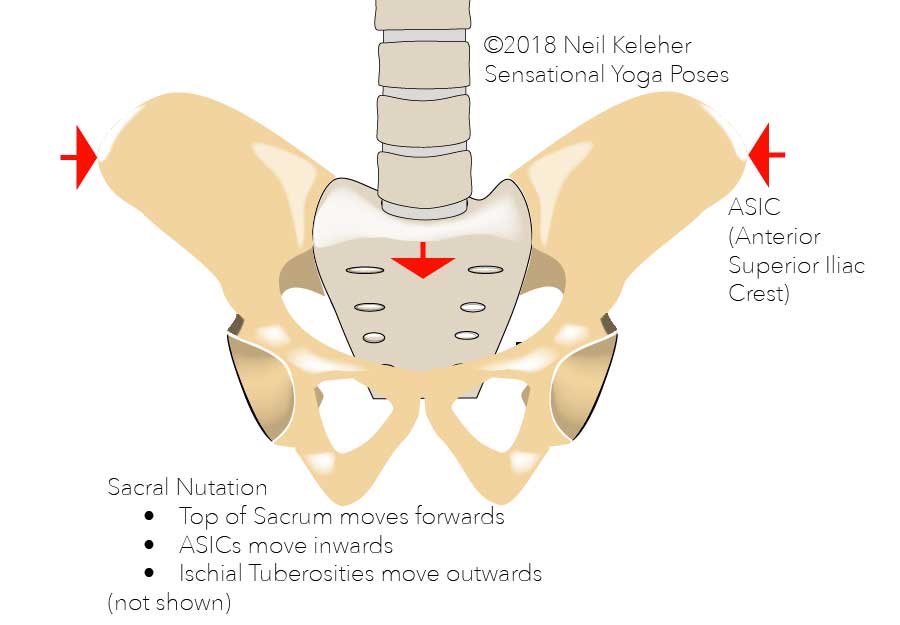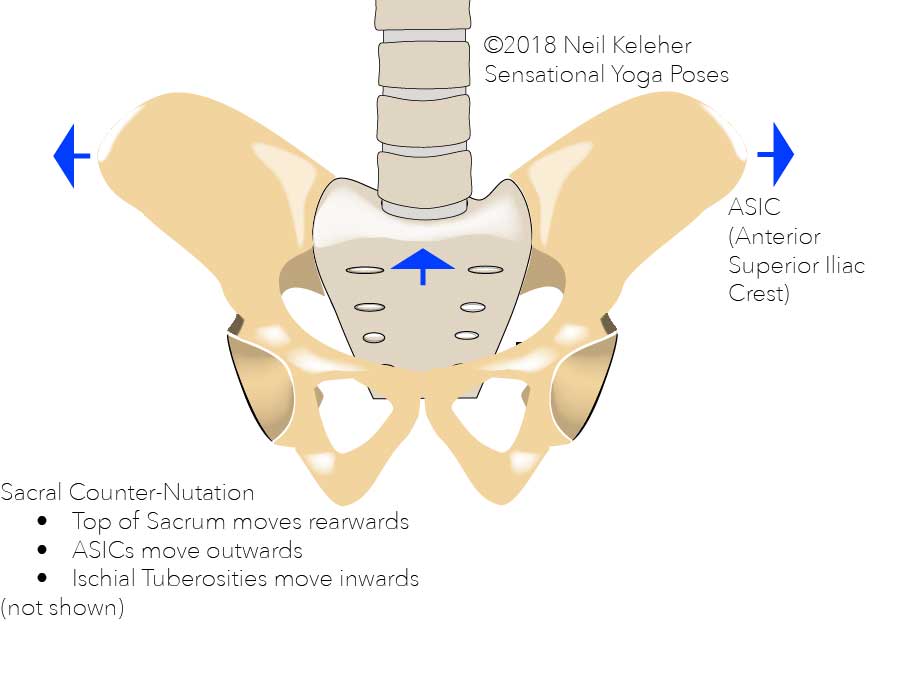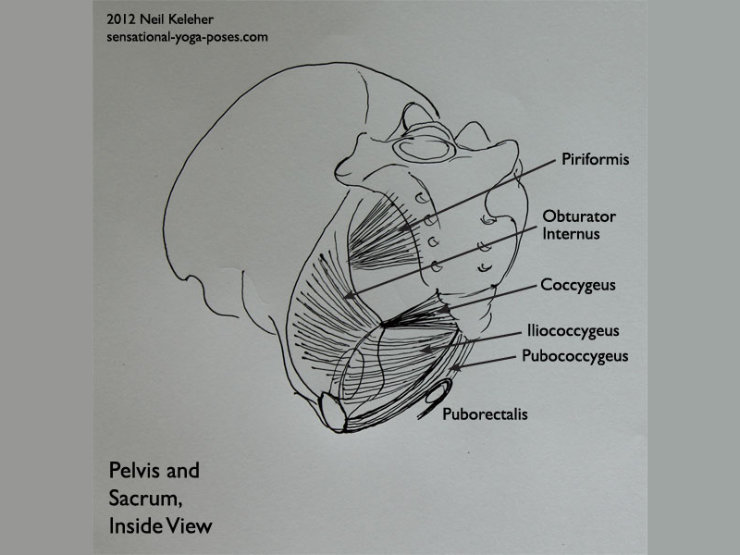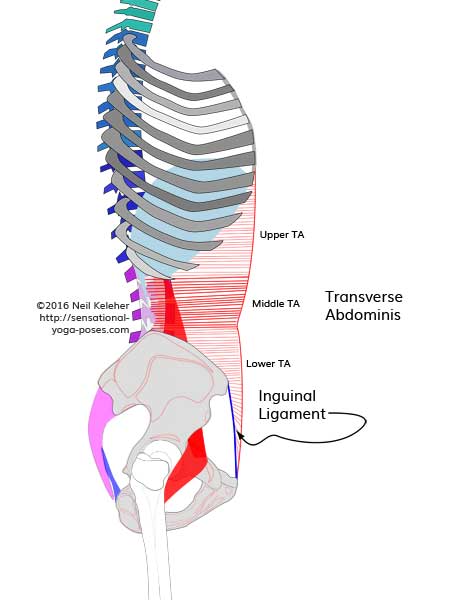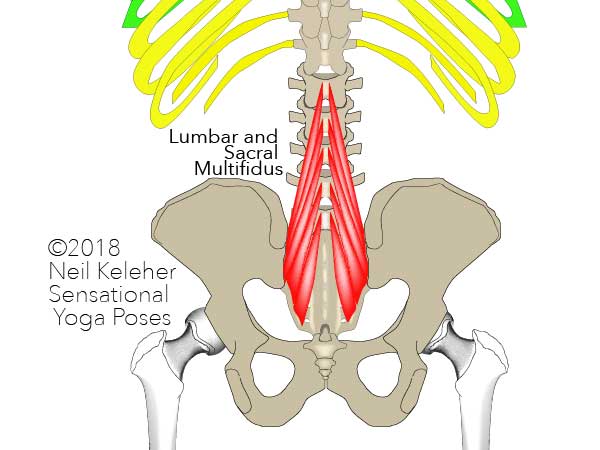Nutation and Counter-Nutation
Two basic movements of the sacrum relative to the hip bones are:
Nutation, where the sacrum nods forwards relative to the hip bones, and
Counter-nutation where the sacrum nods backwards relative to the hip bones.
If we still had tails then nutation would lift the tail while counter-nutation would drop it.
In both cases, the hip bones also move relative to each other and the sacrum.
To take into account asymmetrical SI joint movements, we could describe the hip bones moving relative to the sacrum so that each hip bone can move in opposite directions. Thus:
Counter nutation of an SI joint would mean that the hip bone on that side is rotating forwards relative to the sacrum.
Nutation of an SI joint would mean that the hip bone on that side is rotating rearwards relative to the sacrum.
SI joint stability depends on muscle control and not on the position of the hip bones and sacrum relative to each other.
As a result, SI Joint stabilization can occur whether the SI joints are both nutated or both counter-nutated. It can also occur if one SI Joint is nutated and the other counter-nutated.
Unifying the Pelvis and Spine
Stabilizing both SI joints at the same time effectively unifies both hip bones with the spine via the sacrum. To stabilize both hip joints without directly involving any muscles that act across the hip joints, the lower transverse abdominus, pelvic floor muscles and/or the sacral multifidus can act against each other or body weight.
To stabilize a single SI joint, muscles of the hip joint can be used. As a result, not only is the SI Joint stabilized, but also the hip joint on the same side.
Forces that Can affect SI Joint Stabilization
Part of what follows in this article is descriptions of how to deliberately activate muscles to stabilize the SI Joint. Where problems occurs, where your experience of the exercise is different than what is described, it can be important to take into account other factors (apart from the simple fact that you and I are different.)
In an upright position, the sacrum bears the weight of the upper body, via the spinal column.
If the upper body is shifted forwards and the lumbar lordosis increased, the weight of the upper body will cause the sacrum to nutate or nod forwards.
If the upper body is shifted rearwards slightly, and the lumbar lordosis decreased, the weight of the upper body can cause the sacrum to counter-nutate or nod backwards.
Either of these positions will result in slightly different muscle activations when trying to stabilize both SI Joints at the same time.
Dual SI Joint Stabilization Using the Pelvic Floor Muscles
One way to achieve stability of both SI joints at the same time is by using the lower fibers of the transverse abdominus against the pelvic floor muscles.
There are two layers of pelvic floor muscles, and in regards to SI joint stability the upper layer, consisting of coccygueus, iliococcygeus, pubococcygeus, puborectalis, levator ani and levator prostatae/vaginae is the one to focus on in this regard.
Assuming that the abdominal cavity is not pressurized, then the lower fibers of the transverse abdominus can activate to create an inwards pull on the ASICs.
Unopposed, this would cause the two sides of the pelvis to hinge at the SI joints and pubic bone causing the Ischial tuberosities to move outwards. However, at the same time as the transverse abdominis are activated, the pelvic floor muscles can be used to create a forward pull on the tailbone (towards the pubic bone) while also creating an inwards pull on the Ischial Tuberosities (or Sitting Bones).
This action prevents the ischial tuberosities from spreading and both sets of muscles end up working against each other to stabilize both SI Joints.
Using the Transverse Abdominus against the Pelvic Floor Muscles
The general sequence for activating the pelvic floor for SI joint stabilization is to pull the tailbone forwards first, then pull inwards on the Ischial Spines.
Note how the coccygeus muscle attaches from the tailbone to the inner surface of the Ischial spine.
Pulling forwards first on the tailbone (pulling it towards the pubic bone) activates pubococcygeus.
Then pulling inwards on the ischial spines (or the Ischial tuberosities, since they are quite close together) activates the coccygeus.
Creating an inwards pull forwards of the ischial spine then activates the iliococcygeus.
Tension can be further increased by pulling forwards on the Anus and then the perineum. (These are two distinct actions!).
To Activate, Muscles Have to Work Against Some Force
For you to be able to feel your pelvic floor muscles activate, they have to be working against an opposing force. In the absence of abdominal pressurization, that force is provided by the lower band of fibers of the Transverse abdominus.
Here you can see Transverse Abdominis muscle divided into three layers. The bottom most layer can be used to oppose the pelvic floor muscles and stabilize both SI joints at the same time.
Pulling Inwards on the Ischial Tuberosities
In the above description of pelvic floor activation, an important step is pulling inwards on the ischial tuberosities.
If you just pull forwards on the tail bone, you may not feel your lower transverse abdominis activate. The reason for this is that in order to activate, they need to work against the pull created by trying to pull inwards on the ischial tuberosities.
Tightening the Anal Sphincter
A very simple action that may get similiar results to those described in the box above is to tighten the anal sphincter.
You may find that if you tighten it past a certain point you get a lifting sensation as if the anus is being pulled up into the body.
Note that the intent isn't to directly lift the anus but to tighten it so that the lift is created as a result of that tightening.
Counter-nutated SI Joint Stabilization in Spinal Forward Bends
Standing with feet apart and knees slightly bent, what I find is that when I activate the pelvic floor against my Transverse abdominis, my pelvis tends to tilt backwards. The amount of backward tilt isn't huge but is noticeable.
Why does this happen?
When activating the pelvic floor muscles the first activation is to pull the tailbone towards the pubic bone. This means that the sacrum tilts or nods backwards (counter-nutation). That means the top of the sacrum (called the "base") moves backwards.
Since the sacrum supports the base of the lumbar spine, the lumbar spine has to adjust to allow this movement. That in turn causes the whole pelvis to tilt backwards.
When the pelvis tilts backwards while standing it tends to straighten the flatten the lordosis of the lumbar spine, removing its rearwards curve. This suggests that a good place to begin exploring counter-nutation using the transverse abdominis versus the pelvic floor muscles is in postures or actions where the spine is bending forwards.
Going back to the idea of tails, if you've seen a dog with its tail between its legs you may have noticed that its lower lack bends forwards to accomodate this tail position.
Dual SI Joint Stabilization Using the Sacral Multifidus
Another way to stabilize both SI joints without involving the hip muscles is to use the sacral (and lumbar) multifidus. Here again the lower fibers of the transverse abdominus can be used in opposition.
Because the lower transverse abdominus can oppose both the multifidus and the pelvic floor muscles it may be helpful to think of the SI joints as having an upper portion and a lower portion.
The two hip bones can pivot around the lower part of the SI joints causing the ASICs and ischial tuberosities to move in opposition or
The two hip bones can pivot around the upper part of the SI joints causing the ASICS and PSICs to move in opposition.
Nutation may tend to focus forces on the upper part of the SI joints while counter-nutation may tend to focus forces on the lower part of the SI joints
Sacral Multifidus
In the sacral region the multifidus fasciculi attach to the back of the sacrum and also the inner edges of the hip bones, where the hip bones protrude past the rear surface of the sacrum (the PSIS).
They also attach to the posterior sacroiliac ligaments and to the front surface of the spinal erector aponeurosis.
- A Fasciculi (singular fascicle) is a bundle of muscle fibers.
- An Aponeurosis could be thought of as a bundle or sheath of tendons. The tendons are bundled in such a way that they can slide easily relative to each other.
Using the Multifidus to Move the Tailbone Rearwards
If you stand with with your upper body slightly forwards relative to the pelvis and with your pelvis tilted forwards so that your lumbar spine has a noticeable lordosis, the weight of your upper body will act via the spine to nutate the sacrum.
Your hip bones will be prevented from tilting further forwards possibly by your hamstrings creating a downwards pull on your ischial tuberosities. The weight of your upper body via the spine will be trying to increase the forward tilt or nod of your sacrum.
Assuming that the forward tilt of the sacrum isn't resisted by the pelvic floor muscles, then the weight of the upper body pressing down through the top of the sacrum will cause it to nutate relative to the hip bones.
You can accentuate the nutation with the help of the sacral multifidus muscles.
If you know what it feels like to activate your spinal erectors, try creating the same feeling at the back of your sacrum and tailbone, as if trying to use your spinal erectors to lift your tailbone and tilt your sacrum forwards. You may notice a tightening sensation at the back of your sacrum indicating that your sacral multifidus are activating.
Because the multifidii in part attach to the inner edge of the hip bones at the psis, when they activate they tend to create an inwards pull on the PSIS which then causes the ASICs to move outwards since the two hip bones hinge at the SI Joints.
The greater the lift of your tailbone, the greater this inner force at the PSIS and the greater the outwards movement of the ASICs. And so with a stronger activation you may find your lower belly pulling in, a sign that your lower transverse abdominis are activating.
The transverse abdominis activate to resist the outwards movement of the ASICs.
Now you still have a lordosis, but with the multifidus acting against your lower transverse abdominis, your SI Joints are stabilized.
An interesting possible side affect of this is that you give your spinal erectors an anchor point from which to activate and create a backwards bending force on the lumbar spine and from there potentially the rest of the spinal column.
The Thoracolumbar Fascia
The thoracolumbar fascia has a considerable thickening at the back of the sacrum.
When the lower transverse abdominis activates, it can add tension to the thoracolumbar composite, at the back of the SI Joint.
The thoracolumbar composite is a fused mass of connective tissue that ties the PSIS of both hip bones together behind the sacrum.
Activating the transverse abdominis to pull the ASICs inwards causes an outwards force on the two PSIS which adds tension to this thoracolumbar composite.
Since the lumbar multifidus also has attachments to layers of this fascia (which includes the spinal erector aponeurosis), tensing this composite via the transverse abdominis may help to provide an anchor for effective activation of the sacral multifidus.
The action of the the multifidus can be accentuated by a feeling of trying to point the tailbone rearwards. You could also imagine "lifting your tail."
Nutated SI Joint Stabilization in Spinal Backbends
Nutating the sacrum while standing tends to cause the pelvis to tilt forwards which instigates a backward bend of the spine at the sacrum. As a result, you may find it interesting to investigate nutations while doing spinal backbends. You can explore this more in Spinal Back Bending Exercises and Spinal Back Bending Yoga Poses.
As mentioned, with the sacral multifidus working against the transverse abdominis, not only is the SI Joint stabilized, but the spinal erector aponeurosis is firmly anchored meaning that the spinal erectors and other paraspinal muscles can work effectively to bend the spine backwards from the bottom upwards.
This same action spreads the sitting bones which then adds tension to the Sacrotuberous ligament, which as the gluteus maximus and hamstring muscles both have attachments here, gives those muscles a fixed anchor from which to bend the hips backwards.
It's for this reason that most of the descriptions in Spinal Back Bending Yoga Poses start with back bending the spine (by leading with the sacrum) with gluteus maximus (and hamstring) activation done afterwards.
SI Joint Backbends and Forward Bends
Understanding that nutation of the sacrum tends to go along with activation of the spinal erectors and other muscles along the rear surface of the spine, it may seem logical to assume that counter-nutation will go along with action of muscles that attach to the front of the spine.
In the lumbar and sacral regions this can include the piriformis muscle, which attaches to the front surface of the sacrum, and the psoas muscle which attaches to the front side of the lumbar vertebrae (to the sides of the vertebral bodies and intervening discs and also to the fronts of the transverse processes.)
The Sacrotuberous Ligament and SI Joint Stability
In some subjects, the biceps femoris was found to connect directly to the sacrotuberous ligament.
For some people, this connection could help to stabilize the SI Joint while it is nutated even if the multifidii are not active. In this case stability could be created by increasing tension on the sacrotuberous ligament which helps to resist nutation of the sacrum.
Another way to add tension to the sacrotuberous ligament on both sides is to use the obturator internus muscle to create an outwards pull on the sitting bones.
SI Joint Stabilization Options
In the next article we'll look at single SI Joint stabilization which involves stabilizing the same side hip joint.
One thing to be aware of when practicing dual SI Joint stabilization as described in any of the exercises above is that just as important as feeling your transverse abdominus, pelvic floor and multifidus activate is feeling them relax.
Muscles are designed to activate and relax and so I would strongly suggest not trying to keep any of the above mentioned muscles active for long periods of time (long periods being anything over a couple of breaths!)
So why bother with these exercises at all? To help you become more aware of your body and so that you can experiment with these actions in the context of yoga poses.
If activation helps in the context of a yoga pose, perhaps while moving in and out of a challenging position, then use it. But so that you have options, lean next about how to stabilize one SI joint at a time using the hip muscles.
Published: 2020 08 14
Updated: 2020 11 04
